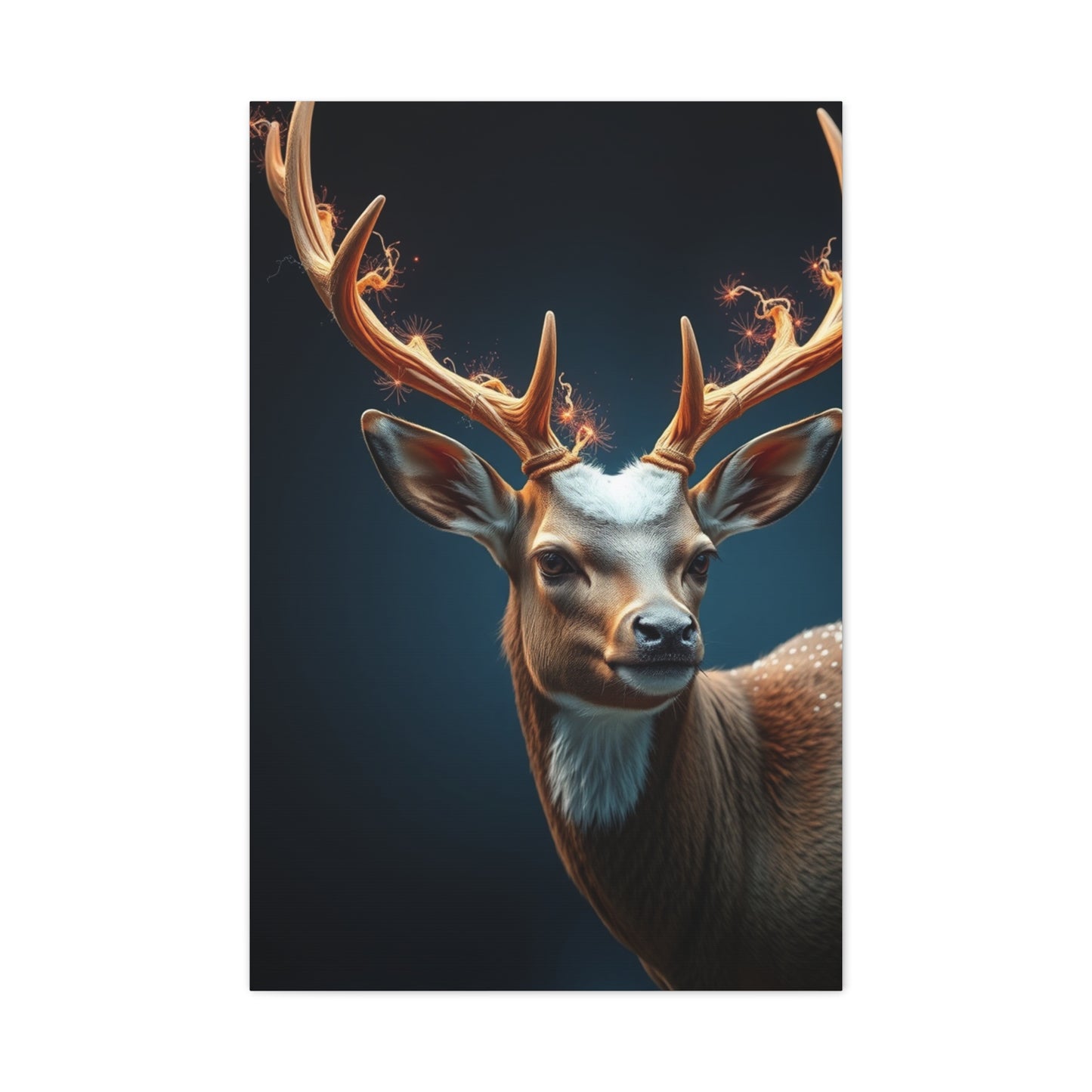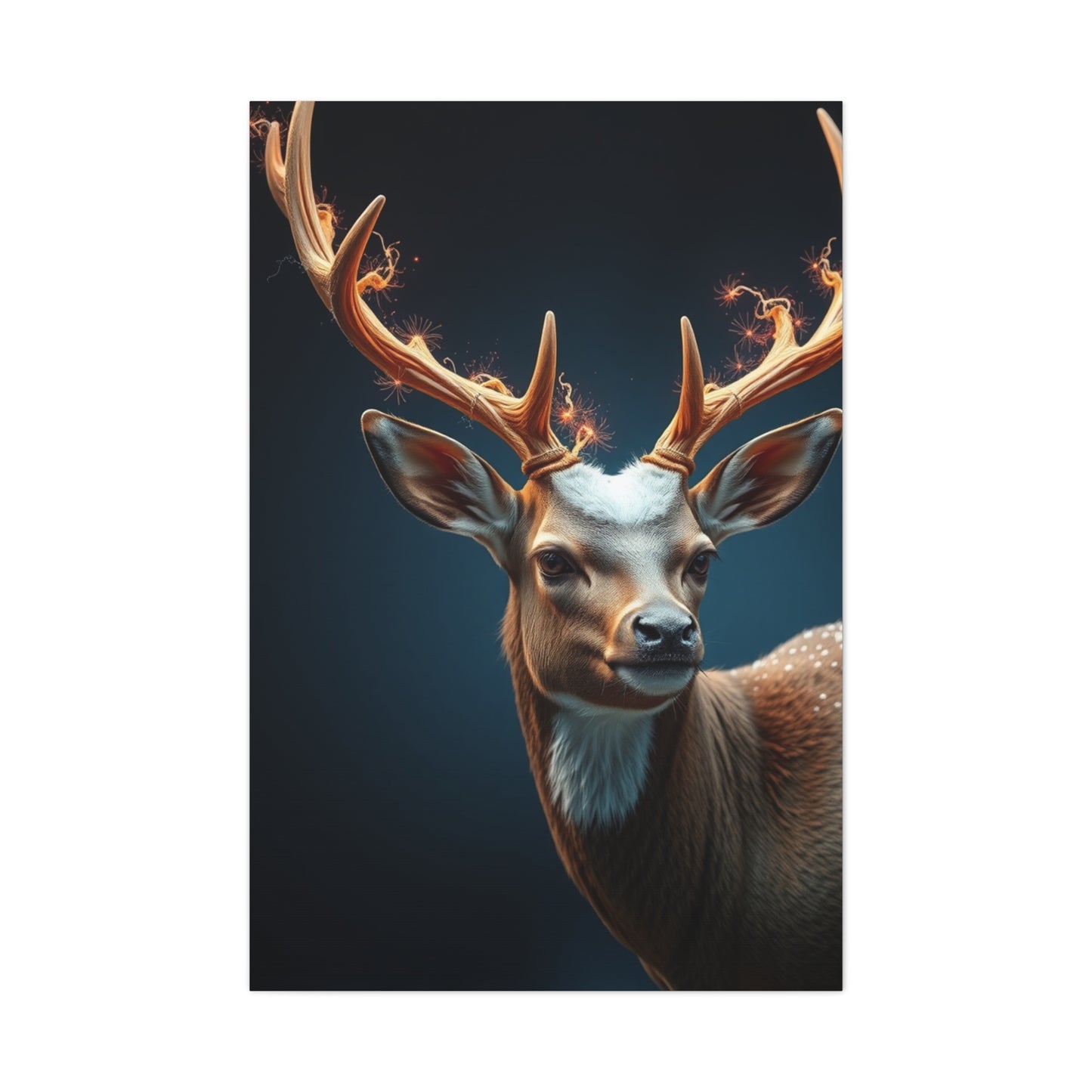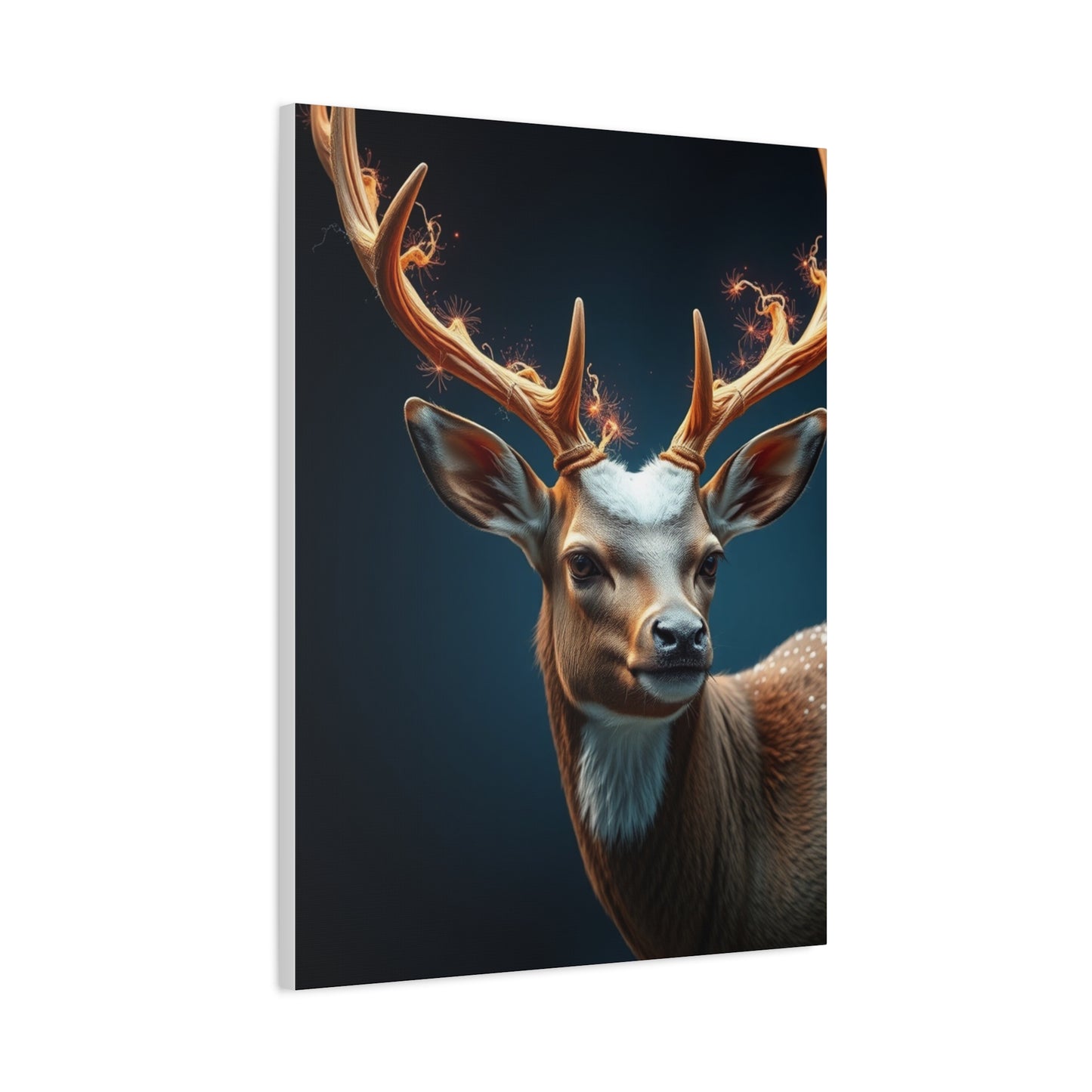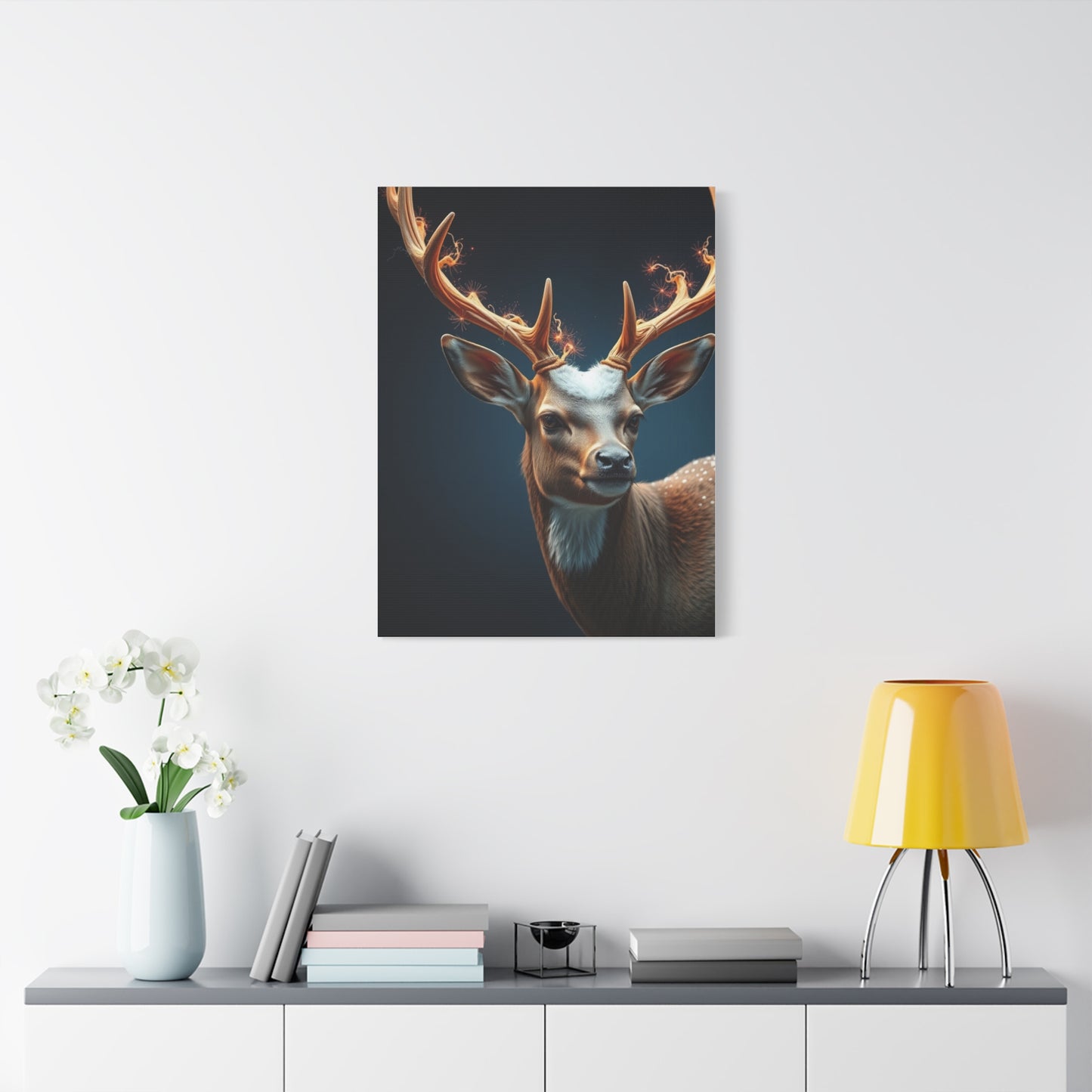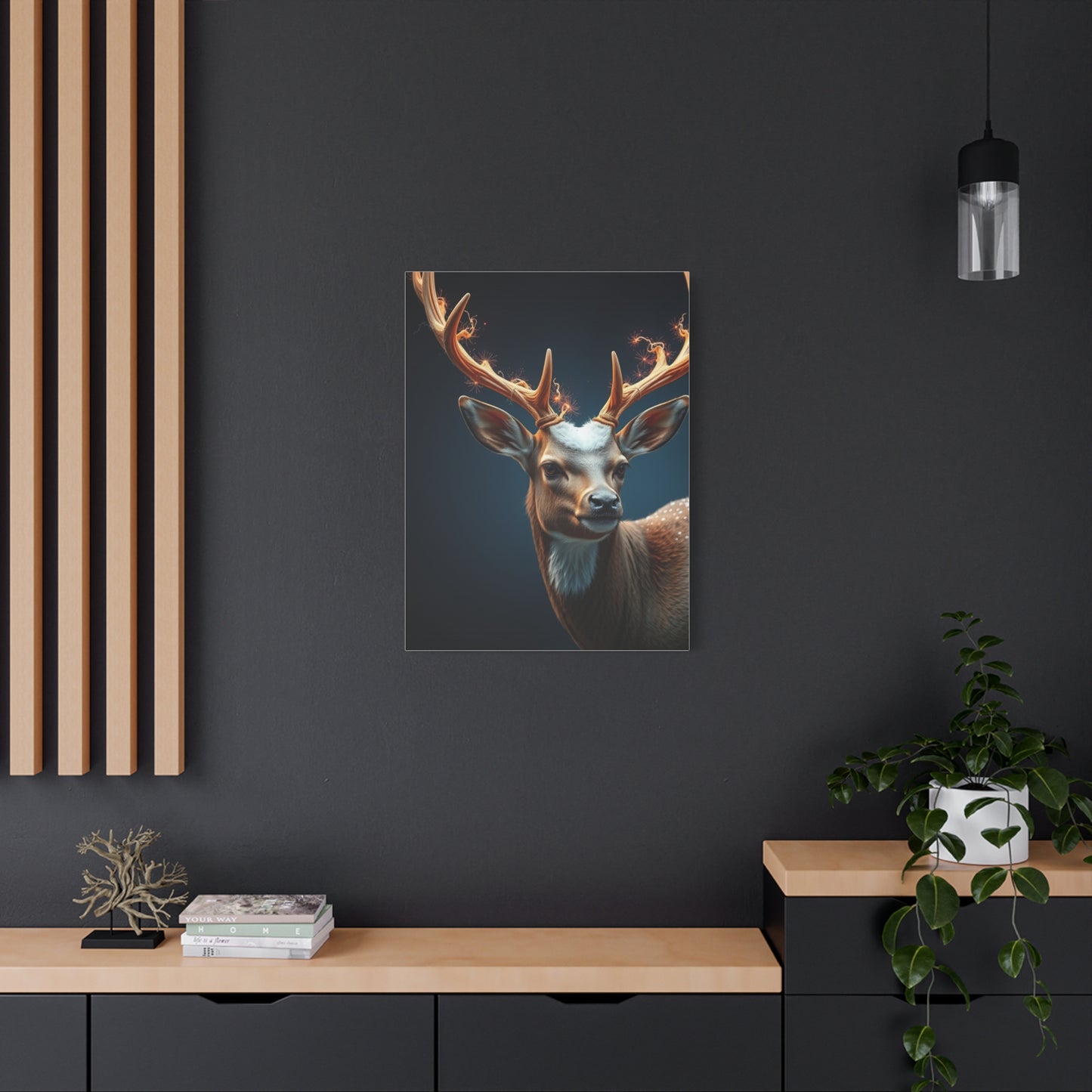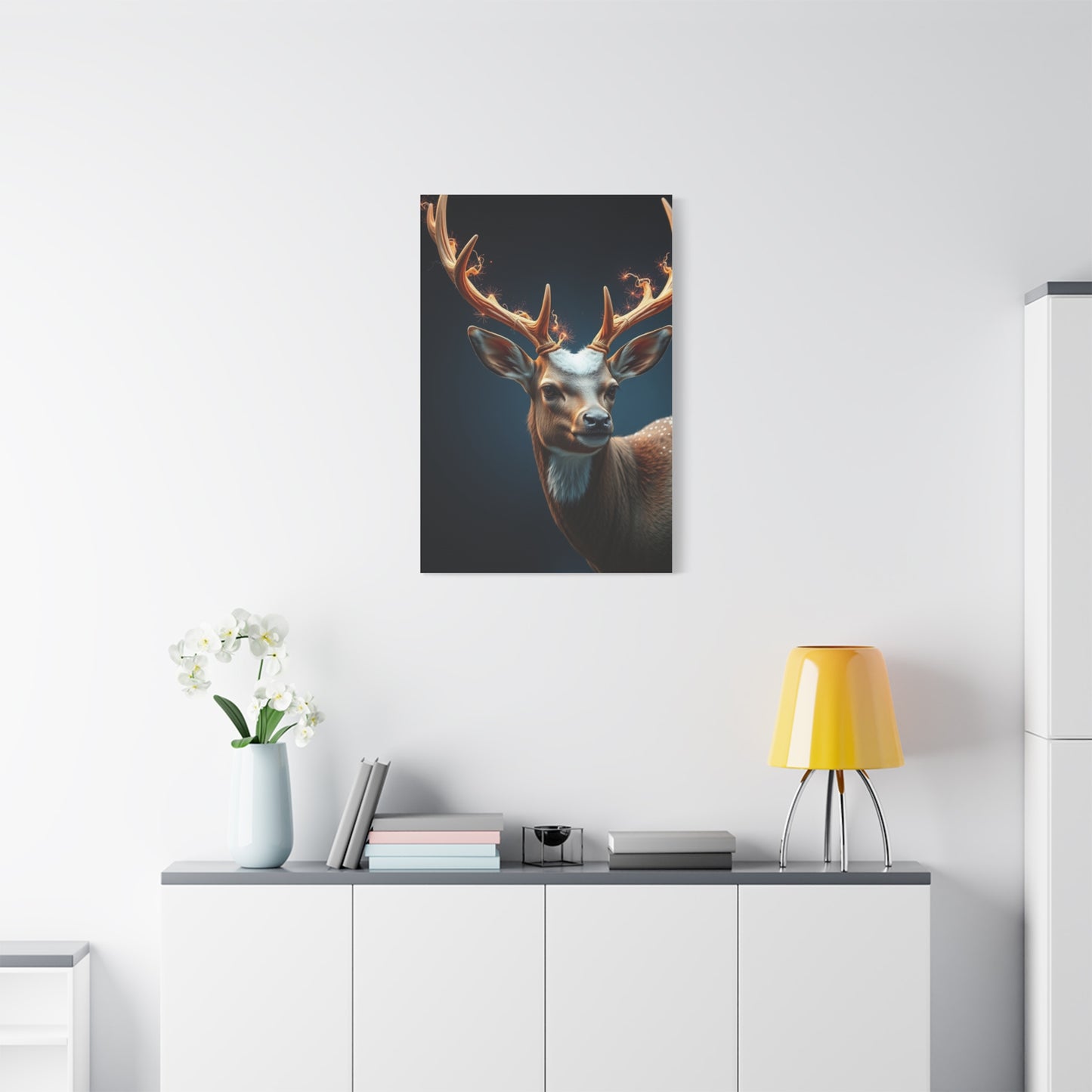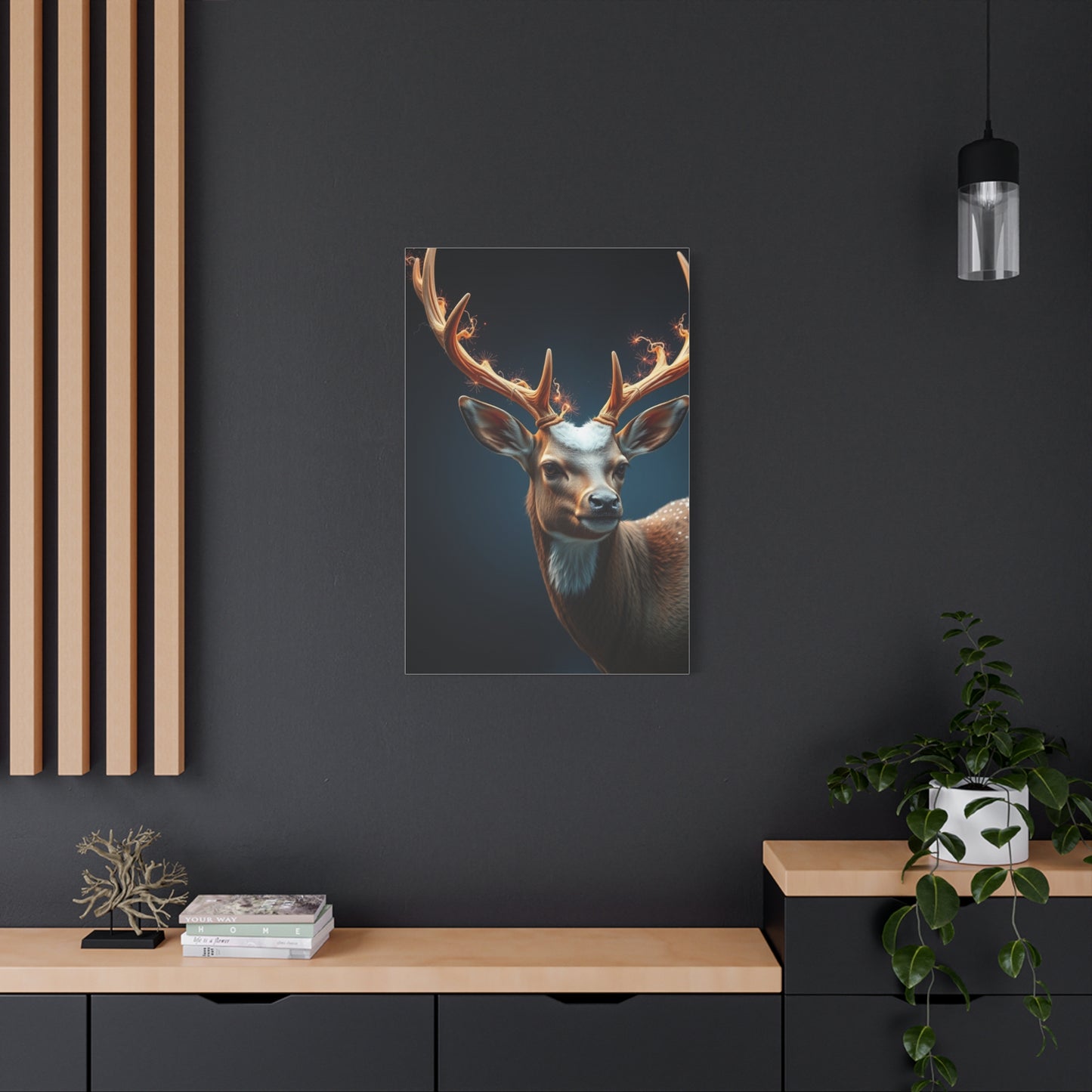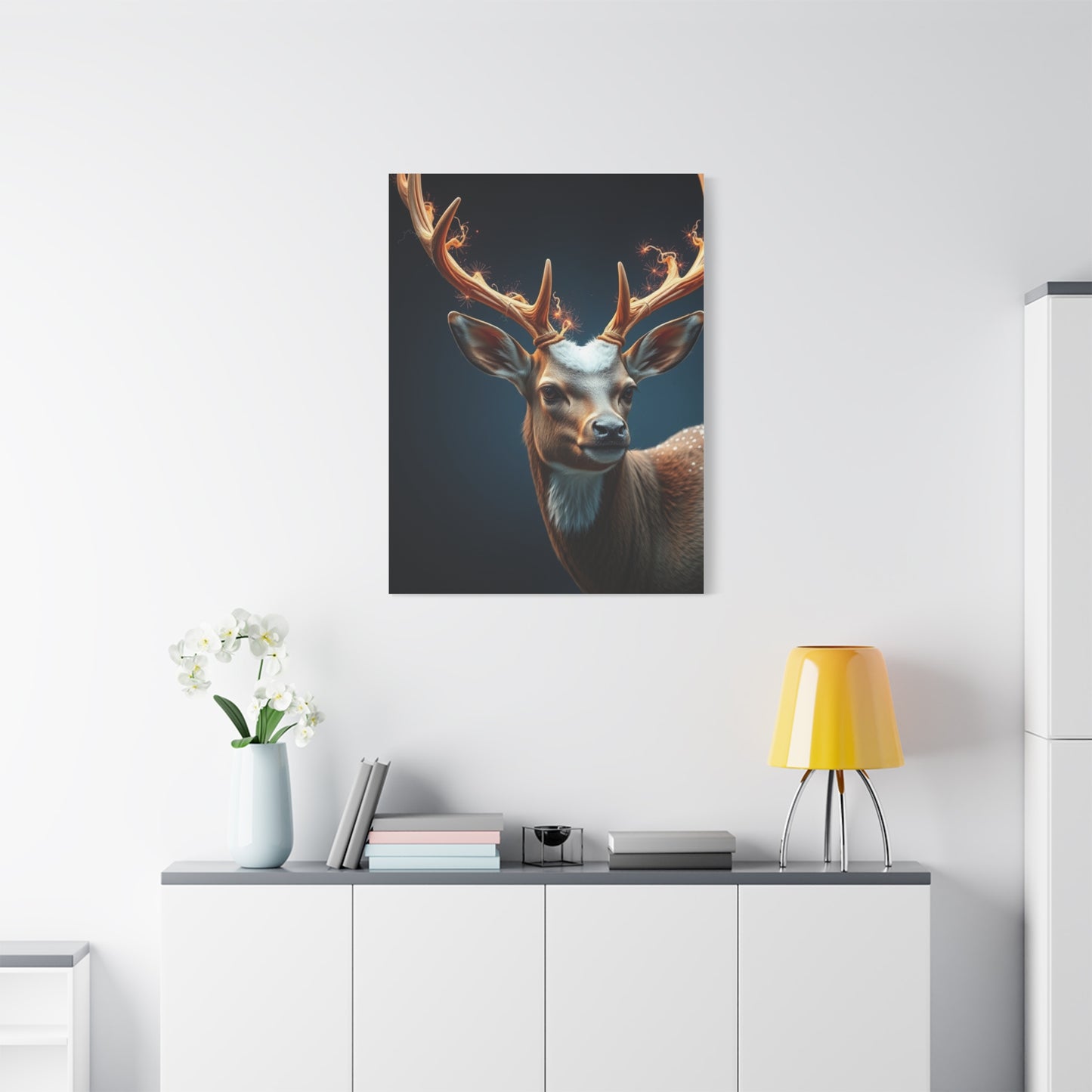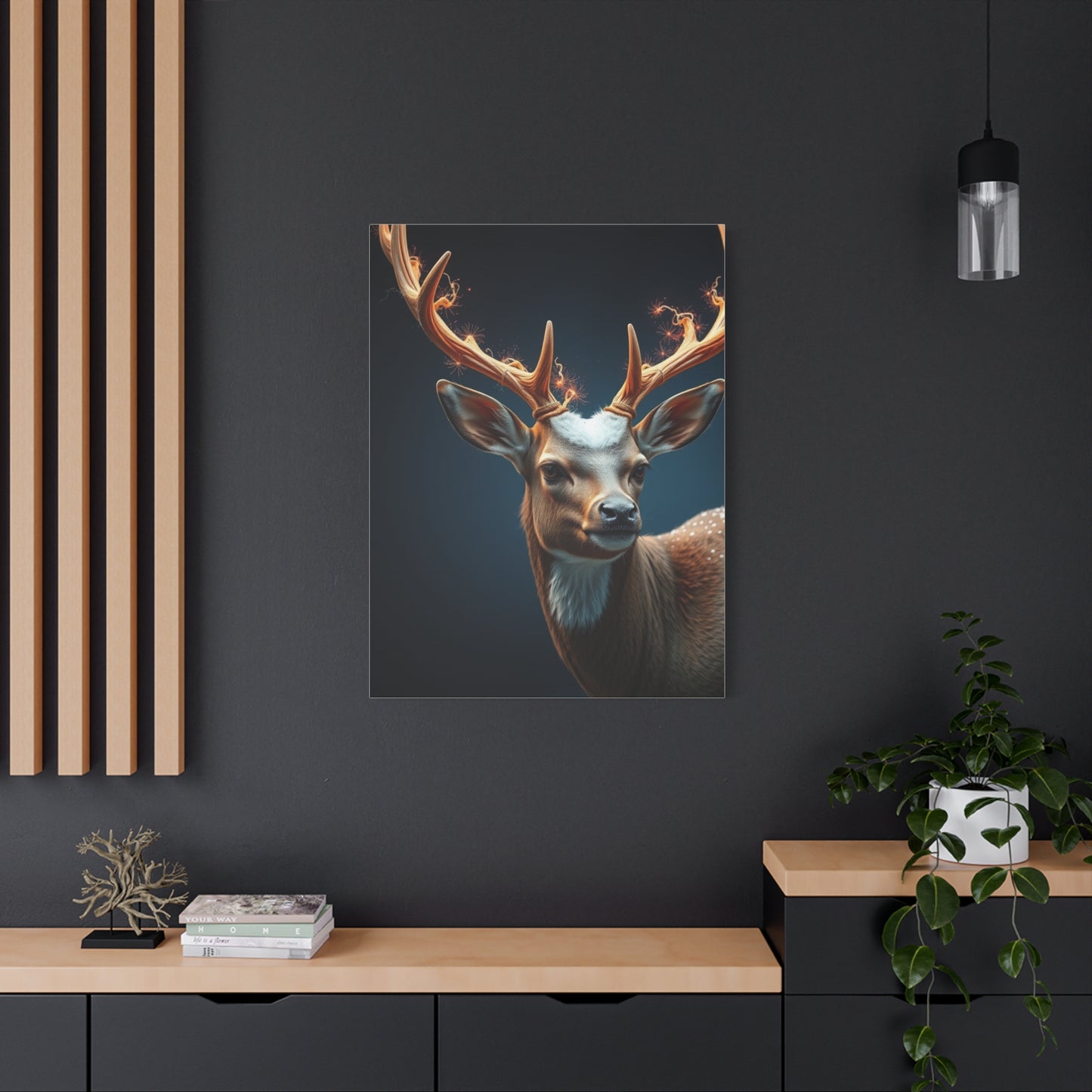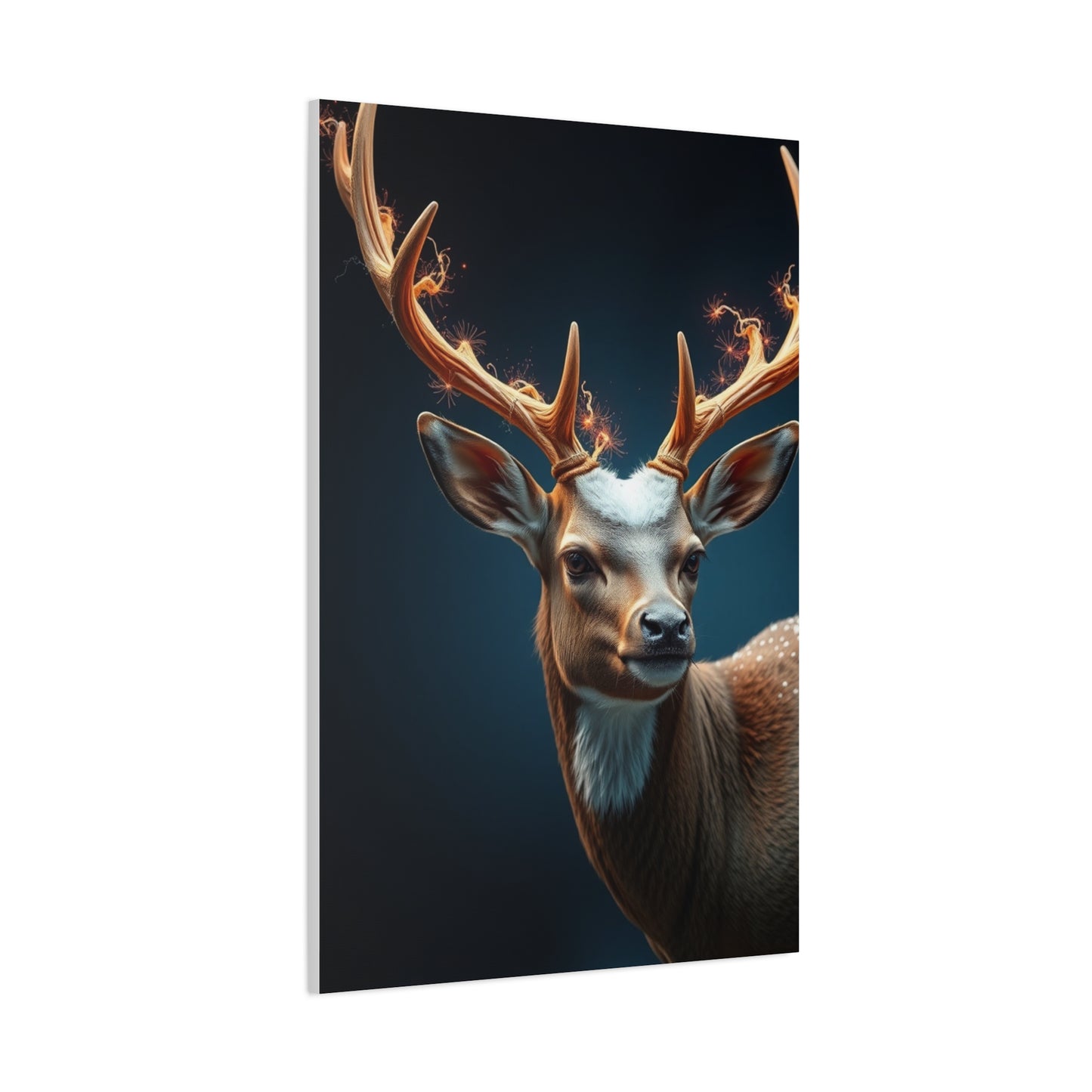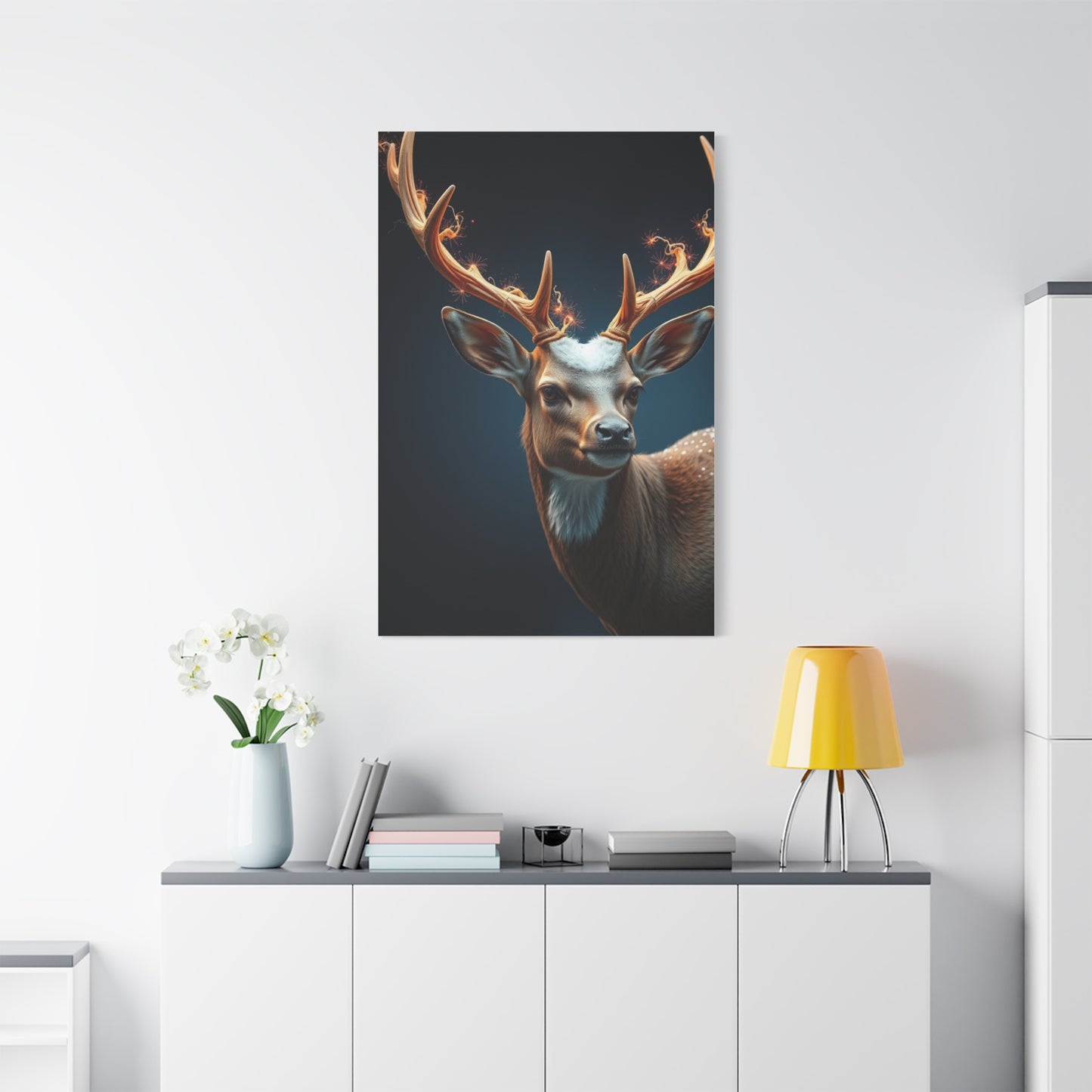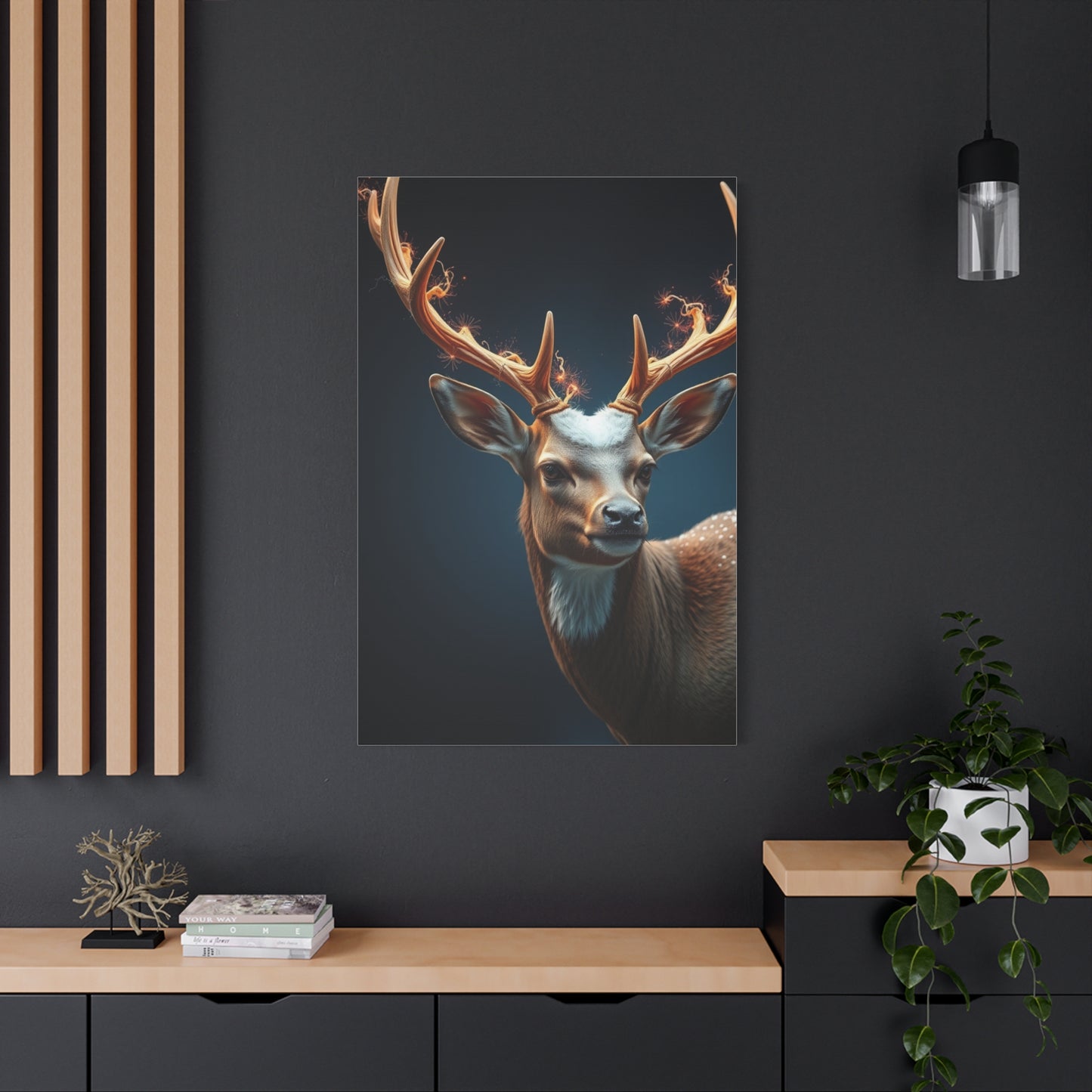The Art of Serenity: A Comprehensive Guide to Graceful Antler Portraiture Wall Art
In the vast and ever-evolving world of interior design, certain motifs possess a timeless quality, an ability to transcend fleeting trends and speak to a deeper, more intrinsic human appreciation for beauty. Among these enduring themes, the depiction of nature, and specifically majestic wildlife, holds a special place. The graceful antler portraiture wall art canvas print stands as a prime example of this phenomenon, capturing a unique intersection of raw, untamed wilderness and refined artistic elegance. This form of art is not merely a decorative element; it is a statement piece, a narrative, and a window into a world of serene grandeur. The appeal of such artwork lies in its profound ability to evoke a sense of calm and connection to the natural world, something increasingly sought after in our fast-paced, digitally dominated lives.
A canvas print featuring the intricate and powerful form of antlers, rendered with a delicate and graceful touch, can transform a sterile room into a sanctuary of peace and contemplation. It speaks of strength without aggression, of majesty without ostentation. This subtle power is what allows graceful antler portraiture to harmonize with a multitude of decor styles, from the rustic charm of a country lodge to the clean, minimalist lines of a contemporary urban apartment. The canvas as a medium further enhances this allure, offering a textured, gallery-quality feel that adds depth and sophistication to the artwork, making it feel less like a poster and more like a cherished piece of fine art.
Deconstructing the Elements: What Makes Antler Portraiture 'Graceful'?
The term 'graceful' is not applied lightly when describing this specific genre of wildlife art. It signifies a deliberate artistic approach that moves beyond a simple anatomical rendering of a deer or stag. Grace in this context is a confluence of several critical artistic elements, each working in concert to create a piece that is both visually stunning and emotionally resonant. Firstly, the composition plays a pivotal role. A graceful antler portrait often utilizes negative space masterfully, allowing the subject to breathe and command attention without overwhelming the viewer. The positioning of the animal, whether a direct gaze or a more contemplative profile view, is carefully chosen to convey a specific mood—be it quiet confidence, gentle curiosity, or serene watchfulness. Secondly, the use of light and shadow is paramount.
The artist might employ soft, diffused lighting to highlight the elegant curvature of the antlers and the soft texture of the animal's fur, avoiding harsh contrasts that could feel aggressive or jarring. This technique, known as chiaroscuro, sculpts the form and adds a three-dimensional quality, making the portrait feel alive. The color palette is another defining characteristic. Graceful portraiture often leans towards muted, earthy tones, monochromatic schemes, or soft, ethereal pastels that contribute to a calming and sophisticated ambiance. Finally, the artist’s rendering of the subject’s expression and posture is the soul of the piece. It is in the subtle tilt of the head, the gentle look in the eyes, or the relaxed posture of the neck that the true essence of grace is captured, transforming a depiction of a wild animal into a profound portrait of nature’s quiet dignity.
The Majestic Symbolism of Antlers and Deer in Art History
Throughout human history, across countless cultures and civilizations, the deer and its magnificent antlers have been powerful symbols woven into the fabric of art, mythology, and spirituality. This deep-seated symbolism is part of what gives graceful antler portraiture wall art its profound resonance. Antlers themselves are a potent emblem of life, growth, and regeneration. Because they are shed and regrown annually, they represent the cyclical nature of life, death, and rebirth. Each new set grows larger and more complex, making them a powerful metaphor for wisdom gained through experience and the continuous journey of personal development. In many ancient cultures, the stag was seen as a king of the forest, a protector of its inhabitants, and a symbol of strength, virility, and leadership. Its antlers were often depicted as a crown, signifying nobility and a sacred connection to the divine.
In Celtic mythology, the white stag was a messenger from the Otherworld, guiding heroes on epic spiritual quests and representing the untamable beauty of the natural world. Similarly, in various Native American traditions, the deer symbolizes gentleness, intuition, and sensitivity. It teaches the power of kindness and the importance of moving through life with grace and awareness. When we hang a graceful antler portraiture canvas print in our homes, we are not just displaying an image of an animal; we are subconsciously tapping into this rich tapestry of universal symbolism. The artwork becomes a modern-day talisman, imbuing our personal space with connotations of natural strength, serene wisdom, and a timeless connection to the wild.
Choosing the Perfect Canvas Print: A Guide to Quality and Longevity
When investing in a piece of wall art that is intended to be a long-term feature of your home, understanding the markers of quality is essential. Not all canvas prints are created equal, and the difference between a mediocre product and a high-quality piece of art lies in the materials and the production process. For a graceful antler portraiture wall art canvas print, the goal is to find a piece that faithfully reproduces the artist's original vision and will withstand the test of time. One of the most important factors to consider is the printing method. The gold standard for fine art reproduction is the giclée printing process. Giclée printers use up to 12 different high-quality archival pigment inks, which allows for a much wider and more accurate color gamut than standard printers. This process ensures that the subtle gradients, deep blacks, and delicate tones within the antler portrait are rendered with exceptional clarity and depth. The canvas material itself is another critical component.
Look for prints made on heavyweight, archival-grade canvas, often a poly-cotton blend, which resists yellowing and cracking over time. The texture of the canvas should be fine enough to hold intricate detail without being distracting. Equally important is the frame upon which the canvas is stretched, known as the stretcher bars. These should be made from solid, kiln-dried wood, like pine, to prevent warping or bowing due to changes in humidity. A well-constructed print will have tight, "gallery-wrapped" corners, where the image extends around the sides of the frame, providing a clean, contemporary look that can be hung without an external frame. Finally, a high-quality canvas print should be finished with a protective coating or varnish that is UV-resistant and waterproof, safeguarding the art from fading, moisture, and dust.
Integrating Antler Wall Art into Various Interior Design Styles
The remarkable versatility of graceful antler portraiture is one of its most compelling attributes, allowing it to enhance a wide spectrum of interior design aesthetics. Its ability to adapt stems from its blend of natural subject matter and sophisticated artistic execution. In a Modern Farmhouse setting, this type of wall art is a natural fit. Placed above a rustic wooden mantelpiece or on a shiplap feature wall, it complements the style's emphasis on comfort, simplicity, and natural materials. It adds a touch of wilderness that feels authentic and curated. For a Scandinavian or Japandi interior, which prioritizes minimalism, light, and natural elements, a graceful antler portrait can serve as a stunning focal point. In a room dominated by neutral tones, light woods, and clean lines, the organic form of the antlers introduces a soft, sculptural element without creating clutter.
The artwork's serene quality aligns perfectly with the hygge concept of creating a cozy, contented atmosphere. Even in a more industrial-style space, characterized by exposed brick, metal accents, and a raw, unfinished feel, antler art can create a beautiful juxtaposition. The soft, organic lines of the portraiture can soften the hard edges of the industrial decor, introducing a touch of nature and elegance that prevents the space from feeling too cold or stark. In a Bohemian or eclectic home, the artwork adds to the layered, collected feel of the space, blending seamlessly with plants, textiles, and other art pieces. It can anchor a gallery wall or stand alone, its symbolic depth adding to the rich narrative of the room. The key is to consider the artwork's color palette and frame style to ensure it harmonizes with the existing decor, proving that the call of the wild can be answered in even the most polished of interiors.
Nature-Inspired Art in Your Living Space
The inclusion of art in our living environments goes far beyond mere decoration; it has a tangible and often profound impact on our psychological well-being. Nature-inspired art, such as a graceful antler portraiture canvas print, is particularly potent in this regard, tapping into the principles of biophilic design. Biophilia is the innate human tendency to seek connections with nature and other forms of life. In an increasingly urbanized world, where direct contact with natural environments can be limited, bringing elements of nature indoors through art serves as a vital psychological bridge. Displaying an image of a majestic stag in a serene forest setting can subconsciously reduce stress and mental fatigue. Studies have shown that viewing scenes of nature can lower blood pressure, reduce cortisol levels, and improve mood.
A graceful antler portrait, with its calming color palette and dignified subject, acts as a visual anchor for mindfulness. It invites the viewer to pause, to breathe, and to momentarily escape the anxieties of daily life. The artwork can foster a sense of tranquility and safety, transforming a room into a personal refuge. For many, the symbolism of the stag—representing strength, resilience, and a quiet confidence—can be inspiring and empowering. Waking up to such an image in a bedroom or seeing it upon returning home to an entryway can serve as a subtle, daily reminder of these admirable qualities. By consciously curating our spaces with art that reflects the beauty, resilience, and serenity of the natural world, we are not just decorating our walls; we are actively nurturing our mental and emotional health, creating a home that is not only beautiful but also restorative for the soul.
Creating a Focal Point: Positioning Your Graceful Antler Portraiture
The placement of a significant piece of art like a graceful antler portraiture canvas print is a crucial decision that can dramatically influence the overall feel and flow of a room. To maximize its impact, the artwork should be positioned as a focal point, drawing the eye and setting the tone for the entire space. The living room is a classic and highly effective location. Hanging the canvas above the primary sofa is a popular choice, as it anchors the seating area and creates a central point of interest. The rule of thumb is to hang the art so its center is at eye level, which is typically around 57 to 60 inches from the floor. The width of the artwork should ideally be about two-thirds the width of the sofa to maintain a sense of balance. Another powerful location in a living room or great room is above the fireplace mantel.
This placement creates a grand, traditional feel, making the artwork the undisputed star of the room. In the bedroom, placing the antler portrait above the headboard can cultivate a serene and restful atmosphere, turning the space into a tranquil retreat. The majestic and protective symbolism of the stag can contribute to a feeling of security and calm, conducive to sleep. The dining room offers another excellent opportunity; positioning the artwork on the main wall allows it to preside over gatherings, sparking conversation and adding a layer of sophisticated ambiance to meals. An often-overlooked but highly impactful location is the entryway or foyer. As the first thing guests see when they enter your home, a stunning piece of graceful antler portraiture makes a powerful first impression, immediately establishing a welcoming and elegant tone.
Harmonizing Your Canvas Print with Color Palettes and Room Textures
Successfully integrating a work of art into a room involves more than just finding the right spot on the wall; it requires a thoughtful consideration of how the piece interacts with the surrounding colors, textures, and materials. A graceful antler portraiture canvas print, with its typically organic and often neutral palette, offers a versatile foundation for creating a cohesive and harmonious interior. One effective strategy is to pull colors directly from the artwork and use them in the surrounding decor. For example, if the portrait features soft grays, warm beiges, or deep forest greens in its background, you can echo these shades in throw pillows, a cozy blanket, or a decorative vase. This technique creates a subtle visual thread that ties the room together, making the art feel like an intrinsic part of the space rather than a later addition. Texture plays an equally important role in creating a rich, layered look.
The organic subject matter of antler art pairs beautifully with natural textures. Consider placing it near elements like a jute or wool rug, linen curtains, a leather armchair, or furniture made from reclaimed wood. The contrast between the smooth surface of the canvas and the tactile qualities of these materials adds depth and sensory interest to the room. If the artwork itself is highly detailed and textured, you might choose to surround it with smoother, more minimalist surfaces to allow it to stand out. Conversely, a very simple, line-art style portrait could be enhanced by placing it on a textured wall, such as one with subtle wallpaper, wood paneling, or a limewash finish. The goal is to create a dynamic interplay between the art and its environment, resulting in a space that feels thoughtfully curated and visually balanced.
The Art of the Gallery Wall: Pairing Antler Prints with Other Pieces
While a large-scale graceful antler portraiture canvas print can certainly stand alone as a powerful statement piece, it can also serve as a magnificent anchor for a gallery wall. A well-curated gallery wall is a deeply personal and visually engaging way to display a collection of art and photographs. The key to success is to create a sense of cohesion while still allowing each individual piece to shine. When using an antler print as the centerpiece, its natural and often majestic theme can guide the selection of the other elements. You could build a collection around a 'woodland' or 'nature' theme, pairing the antler portrait with smaller botanical illustrations, landscape photographs, or abstract art that evokes natural forms and colors. To maintain visual harmony, it's important to establish a consistent element that runs through all the pieces.
This could be a unified color palette, where all the artworks share one or two common colors. For instance, if your antler print is monochromatic, you could pair it with other black and white photographs and sketches. Another unifying strategy is to use consistent framing. Choosing frames of the same color or material for all the pieces can create a polished and intentional look, even if the art styles themselves are varied. When arranging the gallery wall, start by placing your main antler canvas print slightly off-center and then build the other pieces around it. Mix up the sizes and orientations (horizontal, vertical, square) of the other frames to create a dynamic, balanced composition. Lay everything out on the floor first to experiment with different arrangements before making any commitments with nails and hooks. The result will be a stunning, personalized feature that tells a story and showcases your unique aesthetic.
Beyond the Living Room: Unconventional Spaces for Antler Wall Art
While living rooms, bedrooms, and dining areas are the traditional homes for significant pieces of art, the versatility and evocative nature of a graceful antler portraiture canvas print allow it to bring a touch of unexpected elegance to more unconventional spaces within the home. A home office or study is an ideal location for such a piece. In a space dedicated to focus and productivity, the serene and majestic presence of the artwork can be incredibly grounding. The stag, a symbol of wisdom and steady leadership, can serve as a source of quiet inspiration during a busy workday, while the nature theme helps to reduce the stress often associated with work environments. Hallways and stairwells, often treated as purely transitional spaces, can be transformed into captivating galleries. A vertically oriented antler portrait placed at the end of a long hallway can create a dramatic destination point, drawing you through the space.
On a stairwell landing, it can provide a beautiful visual pause, turning a simple ascent into a more mindful experience. Even a thoughtfully designed bathroom or powder room can be elevated by the inclusion of fine art. In a larger bathroom with ample wall space, a graceful antler print can create a spa-like, sanctuary feel, reinforcing a connection to nature and tranquility. In a smaller powder room, it can act as a surprising and sophisticated design element that makes a memorable impression on guests. The key is to ensure the space has adequate ventilation to protect the canvas from humidity and to choose a size that is proportional to the wall, proving that great art can and should be enjoyed in every corner of the home.
Understanding the Artist's Perspective: The Vision Behind Wildlife Portraiture
To fully appreciate a graceful antler portraiture wall art canvas print, it is insightful to consider the immense skill, patience, and vision required from the artist. Creating compelling wildlife portraiture is a discipline that marries the technical proficiency of a portrait artist with the deep knowledge and passion of a naturalist. The artist’s goal is not merely to create a photorealistic copy of an animal but to capture its essence, its spirit, and the intangible quality that makes it a living, breathing creature. This process often begins long before a brush touches a canvas or a camera shutter clicks. It starts with extensive observation and research. The artist may spend countless hours in the wild, studying the anatomy, movement, and behavior of deer in their natural habitat. They learn how light falls on an antler at dawn, the subtle ways an ear twitches to catch a sound, and the look of quiet intelligence in the animal’s eyes.
This deep-seated respect and understanding for the subject are fundamental. In the studio, the artist then translates these observations into a compelling composition. They make deliberate choices about the pose, the lighting, and the background to evoke a specific emotion in the viewer. Is the piece meant to convey power and majesty, or gentleness and vulnerability? The decision to render the portrait in a hyper-realistic style, a soft impressionistic manner, or a stark graphic form is a crucial part of the artistic narrative. Ultimately, the artist acts as an interpreter, bridging the gap between the wild, untamed world and our domestic lives. They invite us to look closer, to see the individual personality within the animal, and to feel a connection to a part of nature we may rarely encounter firsthand.
The Technical Superiority of Modern Canvas Printing Technology
The evolution of printing technology has been a game-changer for art lovers, making high-quality reproductions accessible to a broader audience. The modern process behind creating a premium graceful antler portraiture wall art canvas print is a marvel of precision engineering and material science, ensuring the final product is a true and lasting representation of the original artwork. The journey starts with a high-resolution digital file of the artwork. For the best results, this file must have a high DPI (dots per inch) count, typically 300 or more, which guarantees that even the finest details—like the texture of fur or the subtle striations on the antlers—are captured without any pixelation or blurriness, even on a large-format canvas. The printing itself is most often done using the giclée method, a French term meaning "to spray." This is not your standard desktop inkjet printer.
Giclée printers are sophisticated machines that use a fine spray of up to 12 different archival pigment-based inks. This extensive ink set allows for an incredibly wide color gamut, meaning it can reproduce a vast spectrum of colors with stunning accuracy and subtlety. Unlike standard dye-based inks, pigment-based inks are composed of tiny particles of solid color suspended in a liquid carrier. These pigments are far more resistant to fading from UV light and environmental factors, giving the print archival qualities that can last for over a century without noticeable degradation. The canvas is specifically coated with a receptive layer that precisely controls how the ink is absorbed, preventing bleeding and ensuring sharp, crisp lines. After printing, a protective varnish is often applied, which not only adds a layer of UV and moisture protection but also can be chosen to give the final piece a matte, satin, or gloss finish, further enhancing its visual appeal.
Caring for Your Wall Art Canvas Print to Ensure a Lifetime of Beauty
Investing in a beautiful piece of graceful antler portraiture wall art is just the first step; proper care and maintenance are essential to ensure it remains a stunning feature in your home for many years to come. Fortunately, high-quality canvas prints are relatively low-maintenance, but a few key practices can make all the difference in preserving their vibrancy and integrity. The most significant threat to any artwork is direct sunlight. The ultraviolet rays in sunlight can cause the colors in the print to fade over time, even with UV-protective coatings. Therefore, it is crucial to hang your canvas in a location where it will not be exposed to prolonged periods of direct sunlight. If you must hang it in a bright room, consider using UV-filtering window films. The second consideration is environmental conditions.
Extreme fluctuations in temperature and humidity can cause the wooden stretcher bars to expand and contract, which may lead to the canvas sagging or the frame warping. Avoid hanging your canvas in areas prone to high humidity, such as directly in a bathroom without proper ventilation, or above a heat source like a radiator or active fireplace. For cleaning, simplicity is key. Dust is the most common issue, and it can be gently removed with a soft, dry, lint-free cloth or a feather duster. Never use water, chemical cleaning solutions, or abrasive materials, as these can damage the protective varnish and the ink layer beneath. If you notice a small mark or smudge, you may be able to gently wipe it with a slightly damp cloth, but always test on a small, inconspicuous area first, like the edge of the canvas. By following these simple care instructions, you can protect your investment and enjoy the serene beauty of your antler portraiture for a lifetime.
Antler Art as a Reflection of Personal Identity and Values
The art we choose to display in our homes is a powerful form of self-expression, a visual language that communicates our tastes, passions, and values to ourselves and to others. Choosing a graceful antler portraiture wall art canvas print says something specific about the kind of atmosphere one wishes to cultivate and the ideals one holds. On a fundamental level, it reveals an appreciation for the natural world. It signifies a person who finds beauty and solace in the wilderness, who values the untamed elegance of wildlife, and who may feel a deep-seated need to maintain a connection to nature amidst the concrete and chaos of modern life. It can reflect a longing for simplicity, for the quiet and uncomplicated existence of a creature in its natural habitat. The choice of a 'graceful' portrait, in particular, speaks to a refined aesthetic.
It suggests a preference for strength that is expressed with quiet confidence rather than overt aggression. It shows an appreciation for subtlety, for the nuanced beauty found in soft light, elegant forms, and serene compositions. This is not the art of a hunter displaying a trophy, but rather that of an admirer paying homage to the majestic spirit of the animal. Furthermore, this art can be a reflection of personal aspirations. The stag, with its crown of antlers that are shed and regrown stronger each year, is a potent symbol of resilience, growth, and renewal. For the homeowner, the artwork can serve as a daily, subconscious reminder of their own capacity to overcome challenges, to grow wiser with experience, and to carry themselves with dignity and grace. In this way, the art on the wall becomes more than just decoration; it becomes a mirror, reflecting and reinforcing the very best of our inner selves.
The Role of Lighting in Showcasing Your Canvas Art Masterpiece
The most magnificent piece of art can lose its impact if it is not properly lit. Lighting is one of the most critical and often overlooked elements in interior design, and it plays a particularly vital role in showcasing the beauty and detail of a graceful antler portraiture canvas print. The right lighting can bring the artwork to life, highlighting its textures, deepening its colors, and creating the desired mood, while poor lighting can leave it looking flat, dull, or lost in shadow. Natural light is a wonderful starting point, but as mentioned, it should be indirect to avoid damage. A wall that receives bright, diffused natural light for part of the day is an excellent location. For artificial lighting, the goal is to provide focused, high-quality illumination without creating glare. The best solution is often a dedicated picture light mounted either on the wall above the artwork or on the ceiling.
Track lighting with adjustable heads is a versatile option, allowing you to direct one or more spotlights precisely onto the canvas. When choosing bulbs, look for those with a high Color Rendering Index (CRI), typically 90 or above. A high CRI ensures that the colors of the artwork are rendered accurately and vibrantly, just as the artist intended. The color temperature of the light is also important. A warm white light (around 2700K-3000K) is generally preferred for homes as it creates a cozy and inviting atmosphere that complements the natural subject matter of the antler portrait. The angle of the light is the final piece of the puzzle. Aim for the light to hit the canvas at roughly a 30-degree angle. This angle minimizes glare on the canvas surface and avoids casting distracting shadows from the frame.
From Digital Image to Physical Art: The Journey of a Canvas Print
The transformation of a digital concept or a physical painting into a stunning, tangible graceful antler portraiture wall art canvas print is a fascinating process that blends artistic vision with cutting-edge technology. The journey begins with the source image. This could be a high-resolution photograph taken by a wildlife photographer, a scan of an original oil or watercolor painting, or a piece of digital art created entirely on a computer. The critical first step is ensuring this source file is of the highest possible quality, with immense detail and precise color information. This digital master file is then prepared for printing. A skilled print technician will often review the file, making subtle adjustments to color balance, brightness, and contrast to ensure the image will translate perfectly to the canvas medium. They calibrate their systems to match the artist's original intent.
Next, the file is sent to a large-format giclée printer. This sophisticated machine is loaded with a roll of premium, archival-grade canvas. The printing process itself is meticulous. The printer head moves back and forth across the canvas, spraying millions of microscopic droplets of pigment-based ink per second. The combination of up to 12 different ink colors allows for the recreation of incredibly subtle tonal transitions and a vast, rich color palette. Once the image is fully printed, the canvas is left to dry and cure, allowing the inks to set permanently into the fibers. After curing, a protective coating is applied. This liquid laminate is carefully sprayed or rolled onto the surface, providing a durable shield against UV light, moisture, and scratches. The final step is stretching. The finished canvas is carefully aligned and stretched over a custom-built wooden stretcher bar frame. A craftsperson pulls the canvas taut, securing it to the back of the frame with staples, and meticulously folds the corners for a clean, professional "gallery wrap" finish. The journey is complete, and a fleeting digital image has become a lasting piece of physical art.
Styling for the Seasons: Adapting Your Decor Around Antler Portraiture
One of the hallmarks of a truly timeless piece of art is its ability to remain relevant and beautiful throughout the changing seasons. A graceful antler portraiture canvas print, with its inherent connection to nature's cycles, serves as an ideal anchor piece around which you can adapt your seasonal decor. Rather than changing your main artwork, you can use smaller, more transient decorative elements to reflect the time of year, creating a fresh look while maintaining the room's sophisticated core. In the autumn, you can complement the earthy tones of the antler portrait by introducing rich, warm textures and colors. Think of adding plush throw blankets in shades of burnt orange, deep red, or mustard yellow. A bowl of pinecones or decorative gourds on a nearby coffee table can further enhance the cozy, harvest-time feeling. As winter approaches, you can shift the decor to create a serene, winter-woodland theme.
Swap the autumn-colored textiles for cozy knits and faux fur in shades of cream, silver, and frosty blue. Introduce elements like silver or birch branches in a vase and use candlelight or warm, twinkling fairy lights to create a magical, hygge-inspired atmosphere that echoes the quiet stillness of a winter forest. When spring arrives, breathe new life into the space by pairing the antler art with fresh, vibrant greens. Add vases of fresh tulips or daffodils, switch to lighter linen throw pillows, and introduce botanical prints in complementary frames. The contrast between the established, majestic art and the fresh burst of life creates a beautiful narrative of seasonal renewal. In the summer, embrace a lighter, more airy feel. Use lightweight fabrics like cotton and sheer linen for curtains and throws, and decorate with elements like smooth river stones or bowls of sea glass to evoke a sense of natural, effortless calm.
The Difference Between Photographic and Painterly Antler Portraiture
When selecting a graceful antler portraiture canvas print, you will likely encounter two primary artistic styles: photographic and painterly. Each style offers a distinct aesthetic and evokes a different mood, and the right choice depends entirely on your personal taste and the desired ambiance for your space. Photographic antler portraiture aims to capture reality with stunning clarity and detail. These pieces, created by skilled wildlife photographers, can be breathtakingly realistic, showcasing every fine hair on the animal's coat and every rugged groove in its antlers. They often have a documentary-like quality, offering a true-to-life window into the animal's world. This style is perfect for modern, minimalist, or contemporary interiors where clean lines and a sense of authenticity are prized. A high-resolution black and white photograph of a stag, for example, can be an incredibly powerful and sophisticated statement piece.
Painterly antler portraiture, on the other hand, involves an artist's interpretation of the subject. This can range from realistic oil or acrylic paintings to more abstract or impressionistic watercolors. In a painterly style, the artist is less concerned with capturing every minute detail and more focused on conveying emotion, movement, and the play of light. You might see visible brushstrokes, blended colors, and a softer focus, which can lend the artwork a dreamy, romantic, or more traditional feel. This style is beautifully suited to homes with a rustic, farmhouse, traditional, or bohemian aesthetic, as it adds a layer of handcrafted warmth and artistic expression. The choice between the two is a matter of personal preference: do you gravitate towards the crisp, objective truth of a photograph, or the emotive, subjective vision of a painting? Both can be equally graceful and captivating.
The Narrative Power of a Single Image: Storytelling Through Antler Art
A truly great work of art does more than just occupy space on a wall; it tells a story. A graceful antler portraiture canvas print, despite being a static image, possesses a profound narrative power that can capture the imagination and evoke a rich inner world for the viewer. The story begins with the subject itself. The stag or deer is not just an animal; it is a character. The artist, through careful composition and rendering of expression, imbues this character with a personality and a history. Is the stag old and wise, its antlers a testament to many seasons passed? Is it young and curious, cautiously observing an unseen presence just beyond the frame? The setting, or lack thereof, adds another layer to the narrative. A portrait set against a misty, atmospheric forest background might tell a tale of mystery, solitude, and ancient magic. The viewer can almost feel the damp earth and hear the silence of the woods.
Conversely, a portrait where the subject is isolated against a stark, minimalist background focuses the entire story on the animal's internal state. It becomes a character study, a meditation on its raw power, grace, and spirit, free from any external context. The viewer becomes a participant in this story. We project our own emotions, memories, and experiences onto the image. Perhaps the serene gaze of the deer reminds us of a peaceful walk in the woods, or its powerful stance inspires a feeling of resilience within us. The artwork becomes a catalyst for contemplation and personal reflection. It is this ability to spark a narrative, to create a world within its frame, that elevates a beautiful picture into a timeless and meaningful piece of art.
Sustainable and Ethical Considerations in Wildlife Art
In an age of increasing environmental awareness, the choices we make as consumers, including the art we buy, can reflect our commitment to a more sustainable and ethical world. When it comes to wildlife art, such as graceful antler portraiture, these considerations are particularly relevant. Choosing to support this genre of art is, in itself, an act that celebrates the natural world and can foster a greater appreciation for wildlife and the importance of conservation. Many wildlife artists are passionate conservationists themselves, using their work to raise awareness about the fragility of ecosystems and the beauty of the creatures that inhabit them. A portion of their sales may even be donated to wildlife preservation organizations. When purchasing a canvas print, you can look for producers who prioritize sustainable practices.
This can include using stretcher bars made from wood sourced from sustainably managed forests, which are certified by organizations like the Forest Stewardship Council (FSC). It can also mean choosing companies that use eco-friendly, water-based pigment inks rather than solvent-based inks, which can release harmful volatile organic compounds (VOCs) into the atmosphere. The printing process itself can be made more sustainable by minimizing waste and using energy-efficient equipment. By consciously seeking out artists and printers who are committed to environmentally responsible practices, you are not only acquiring a beautiful piece of art but also making a choice that aligns with a value for the planet. Your graceful antler portraiture wall art then becomes more than just a depiction of nature; it becomes a small but meaningful contribution to its preservation, a testament to the idea that beauty and responsibility can and should go hand in hand.
The Timeless Appeal of Natural Motifs
Trends in interior design come and go with predictable speed. Colors that are in vogue one year are dated the next, and furniture styles can shift dramatically from season to season. However, amidst this constant flux, some design principles remain steadfast and timeless. The inclusion of natural motifs and biophilic design elements is one such principle, and its importance is only set to grow in the future. As our world becomes more technologically advanced and urbanized, the human craving for a connection to the natural world will intensify. Interior design will increasingly focus on creating spaces that are not just stylish but also restorative and conducive to well-being. This is where art like the graceful antler portraiture canvas print will continue to thrive.
This type of artwork is not tied to a fleeting trend; it is tied to a fundamental human need. The image of a majestic animal, the organic forms of the antlers, and the serene, natural setting it evokes will always resonate. It will continue to be a powerful tool for designers and homeowners looking to create a sense of calm, grounding, and refuge from the outside world. As we move forward, we will likely see these natural motifs integrated in even more creative ways, paired with smart home technology to change lighting based on the artwork's mood, or used as the centerpiece for rooms filled with living plants and natural, sustainable materials. The graceful antler portrait will remain a classic, a symbol of an enduring aesthetic that prioritizes tranquility, elegance, and our unbreakable bond with nature. It is an investment not in a passing style, but in a timeless sense of peace.
Final Contemplation:
Our journey through the world of graceful antler portraiture wall art canvas prints reveals that a piece of art is never just a simple object. It is a confluence of history, symbolism, technology, and profound emotion. It is a testament to the enduring human fascination with the wild and our intrinsic need to bring the serenity and majesty of nature into our most personal spaces. We have explored how the very definition of 'grace' in this art form is a delicate balance of composition, light, and the artist's ability to capture the spirit of a magnificent creature. This is not merely a depiction, but an interpretation—a vision of strength coexisting with gentleness, of power with peace. The deep-seated symbolism of the stag and its antlers, echoing through centuries of mythology and culture, infuses these artworks with a layer of meaning that resonates on a subconscious level, speaking of growth, resilience, and the cyclical beauty of life.
We have also seen the immense versatility of this art, its unique ability to harmonize with an astonishing range of interior design styles, from the rustic warmth of a modern farmhouse to the clean, stark elegance of an industrial loft. It serves as a powerful focal point, an anchor for a room's color palette, and the heart of a personalized gallery wall. Beyond its aesthetic contributions, we have delved into the psychological benefits, understanding how this form of nature-inspired art can act as a tool for well-being, reducing stress and fostering a restorative atmosphere through the principles of biophilic design. The technical precision of modern giclée printing ensures that this beauty is not fleeting, but a lasting investment that can be cherished for a lifetime with simple care. Ultimately, choosing a graceful antler portraiture canvas print is a deeply personal act. It is a reflection of an individual's values—an appreciation for nature, a respect for wildlife, and a desire to cultivate a home that is not just visually pleasing, but is also a sanctuary for the soul. It is a declaration that even in a world of constant motion and digital noise, there is still profound beauty and wisdom to be found in the quiet, dignified gaze of a king of the forest.


















